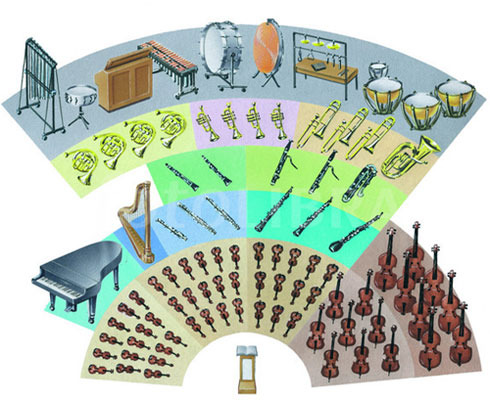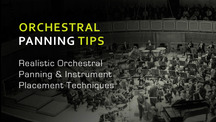If you are a film composer, most of your early work will be with MIDI and sample libraries. This is great for saving money and is essential for low budget films. For this to work, you need your music to sound as realistic as possible. Many sample libraries employ some of these techniques we are going to discuss, but it is still important to place your instruments properly in the stereo field. Realistic Orchestral Panning will get you one step closer to that realistic sound.
Panning For Orchestra
First, what is panning? Panning is the placement of sound in the stereo field. With the advancement of surround sound that also includes the near and far field or front to back positioning of sound.
So, if our goal is to sound like a realistic orchestra we must think like a real orchestra. A typical symphony orchestra will have a string section, a woodwind section, a brass section and a percussion section. Each section is then divided into individual instruments and placed into a standard seating position. The image below shows the typical placement of instruments in the live orchestra.
As we can see in the picture the string section sits at the front of the room and consists of violins, violas, cellos and basses. The woodwinds are a little further back with the brass and percussion sections at the back of the room.
Now lets take the string section and make it as real as possible by panning each individual instrument into its proper place. In this example, we will need to pan our violins to the left of centre, the cellos to the right of centre and the basses we will need to place in the centre. The reason we are placing the basses in the centre is because in real life the bass frequencies tend to envelope an entire room so by placing that section in the middle we can create that feeling.

Other Panning Tricks
Another benefit of panning is the separation of the instruments. Separation is a mixing concept that tries to give each instrument its own space in the final mix. By simply panning each instrument to a different spot in the mix you can achieve this. This is important, as it will help each instrument stand on its own and make your tracks sound clearer.
For those who have cool convolution reverb plug-ins like Altiverb, you can try and experiment with the placement of the sound on the stage. Convolution reverbs use 'Impulse Responses' (a recording of an acoustic space) and some fancy math to make any audio sound like it was played in the room you have selected. In addition to making your audio sound like it is in a real room, you can place your sound in different positions around the "room".
This can be useful when trying to create the ideal virtual orchestra, because we can place the strings at the 'front' of the (artificial) room, and the woodwinds, brasses and percussion 'behind' the strings.
Here is a picture of AltiVerb: the speakers represent what part of the virtual room your audio is coming from.

Conclusion
Panning is a really simple way to improve your overall sound and mix. If you use some of these suggestions you will be on your way to a more realistic digital orchestra. The big key to all these suggestions is to think how the group you are trying to imitate would sound in a live environment.












